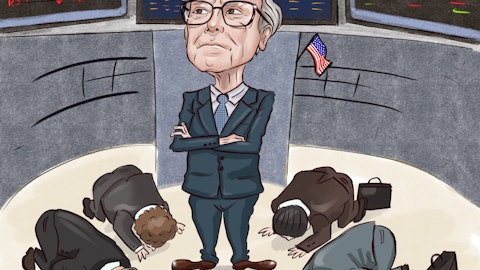Bob Huang: Really appreciate the color. Thank you for reiterating that. Thank you.
Operator: Our next question is from the line of Rob Cox with Goldman Sachs. Please proceed with your questions.
Rob Cox: Hi, thanks for taking my question. Maybe just first question on, one of the higher growth areas of insurance, and thinking about the higher growth areas, one of those is currently the E&S space. And I was just curious on how Aon thinks internally about the feasibility of owning a wholesale broker, and is there any reason, to think that could potentially be a good fit?
Eric Andersen: Maybe I’ll take a stab at that one. Thanks for the question. Listen, there’s been explosive growth in the wholesale market over the last or the E&S market over the last five to seven years. They are on the magnitude of tenfold, there’s a lot that’s driving and, whether it’s the lawsuit. But you see in the property market, whether it’s regulatory pressure on pricing and forms and there’s a lot to it. We have consolidated our wholesale relationships. So that we’re actually working in partnership to get access, to those to that capital when we needed for our clients. Some of our competitors do own wholesalers and that’s the way they chose, to enter into the marketplace. So it’s something we always looked at, but we like where we are today.
And we like the. We like the relationships that we have with our major partner [ph] as we need. That marketplace tends to flex up and down with different market cycles. And so, I would say right now, it is based on the challenging market conditions, especially in the property area. It’s significant, a significant growth, but it will ebb and flow overtime.
Rob Cox: Got it. Appreciate that. And maybe just a follow-up on pricing. I think some of the other brokers have talked about expectations for fairly stable P&C pricing in 2024. I’m curious if Aon shares that view, if there is any other color you’d want to add-on the pricing trajectory?
Eric Andersen: So I think a number of people have commented on it during this earning season. I would say that we’re probably heading towards a market where it’s more of a series of markets where you see price competitive – price competitiveness in certain areas, where new capital has drawn in D&O for example, would be one that’s been called out. You also see challenges still in certain parts of property and people are a little worried about casualty as social inflation from nuclear verdicts have kind of hit the wires. And they’re worried about prior year reserves. So, I think rather than just a rising market for all what we’re going to see over ’24 and ’25, it’s going to be very product specific and very risk specific, which is something that I think plays well to us, because it allows to use our teams in our analytics, to able to help them think through, how they either want to trade, or manage the risks.
And so, but I think that’s where we see the market going in ’24 and ’25.
Greg Case: I maybe just add Rob as well, if you think about impact as it relates to our overall performance bringing it back to Aon. We’ve talked about mid-single-digit or greater. We don’t see anything changing that view. Again, pricing is one aspect, we talked about market impact which includes insured values in a number of other pieces that, fit into the equation. Our ability to work with clients in any type of marketplace than our advantage in doing so. And so, our view is, market will be, what it will be a series of markets as Eric just described. But our ability to deliver mid-single-digit or greater. We feel like, we’re going into ’24 with a lot of momentum behind.
Rob Cox: Appreciate that thanks.
Operator: Our next question is from the line of Elyse Greenspan with Wells Fargo. Please proceed with your questions.
Elyse Greenspan: Hi, thanks, good morning. I wanted to come back to commercial risk. You guys said. I guess there was a 1% impact of business that you put out in dispositions in the quarter overall, right. So that would imply if it impacted commercial risk that, was 2% of the segment, which would bring your organic 2% before that adjustment. And I know you’ve highlighted the M&A and the SPAC [ph] and the IPO slowdown. And I think Greg in response to one of your question. You pointed that the U.S. probably would not have been flat, right, that there’s if we couldn’t really back into that. But what is actually impacting commercial risk away from the M&A and SPAC business that aside from this disposition, the growth would have been 2%?
Greg Case: Christa, you might be on mute.
Christa Davies: Oh sorry. So, Elyse one of the things I wanted to clarify, was on the held-to-sale item, it is across a couple of solution lines and we didn’t disclose the specifics. But we are divesting this business. And so, we think it’s a much better presentation of our organic revenue growth, and the go forward business. And then as we continue to describe, the major impact on commercial risk is the M&A and IPO environment. And that has remained depressed and Eric and Greg have outlined how they see that recovering in 2024, but Eric, would you like to add anything here?





